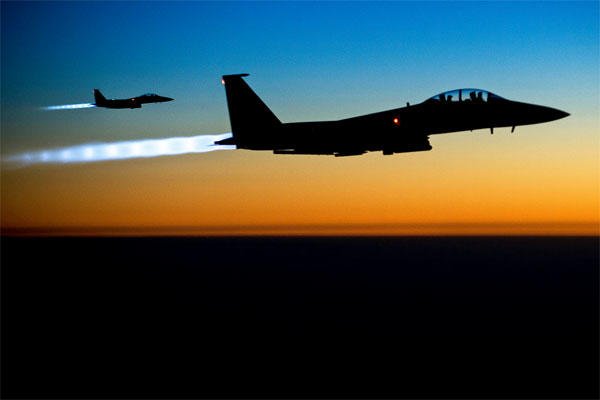The Pentagon gave its most upbeat assessment to date Tuesday on progress in the fight against ISIS while acknowledging for the first time that U.S. Central Command was investigating "credible" incidents of civilian casualties from airstrikes.
U.S. military officials have previously disputed reports of airstrikes killing civilians from human rights and Syrian opposition groups, but Rear Adm. John Kirby, the Pentagon press secretary, said that CentCom was now looking into several "credible allegations of possible civilian casualties" from the airstrikes.
At a Pentagon briefing, Kirby was not specific on where or when the incidents occurred, other than to say that CentCom was investigating allegations made in recent weeks.
"We're very mindful" of the impact that so-called collateral damage can have on efforts to defeat insurgencies following the previous U.S. experience in Iraq and Afghanistan, Kirby said. "It matters to us" to avoid civilian casualties, Kirby said.
More than 1,600 U.S. and coalition airstrikes, combined with support for Iraqi national security forces and Kurdish Peshmerga forces, have put Islamic State of Iraq and Syria (ISIS) fighters on the defensive following their advances into northern and western Iraq last summer, Kirby said.
"We have blunted the momentum they once enjoyed," Kirby said, but "I would not describe where we are in the campaign as a tipping point." Gen. Ray Odierno, the Army chief of staff, has estimated that the campaign to "degrade and defeat" ISIS could take three years.
Kirby said the airstrikes have destroyed hundreds of ISIS vehicles and positions, and killed hundreds of ISIS fighters but he declined to be specific. "We're not getting into an issue of body counts."
ISIS had not made advances "of any significance" in recent weeks although they still threatened the town of Ramadi in western Anbar province and the northeastern oil city of Baiji, Kirby said.
In Syria, the airstrikes and re-supply efforts have allowed Kurdish forces to beat back ISIS attempts that began last September to take the town of Kobani, Kirby said. The town was still under threat from ISIS but "the vast majority of Kobani remains in Kurdish control." ISIS fighters still maintained a foothold but "as they present themselves, we're going to hit them," Kirby said.
On Tuesday, the Combined Joint Task Force-Operation Inherent Resolve reported an additional eight airstrikes in and around Kobani that destroyed 13 ISIS fighting positions and an ISIS building. Also in Syria, U.S. airstrikes destroyed two ISIS tanks in Raqqah, officials said.
Kirby said he could not immediately confirm reports that Kurdish forces had advanced on Monday to take a key district in Kobani including the police headquarters and that they now controlled 80 percent of the town.
Kirby was less upbeat on the effort to recruit, train and equip so-called "moderate" elements in the Syrian opposition to fight against ISIS. The effort has yet to begin but Army Maj. Gen. Michael Nagata, who is in charge, recently held talks with various opposition groups, Kirby said.
The estimate was that training of the Syrian force at expected sites in Saudi Arabia, Qatar and Turkey would begin in the early spring, Kirby said.
-- Richard Sisk can be reached at richard.sisk@military.com





























